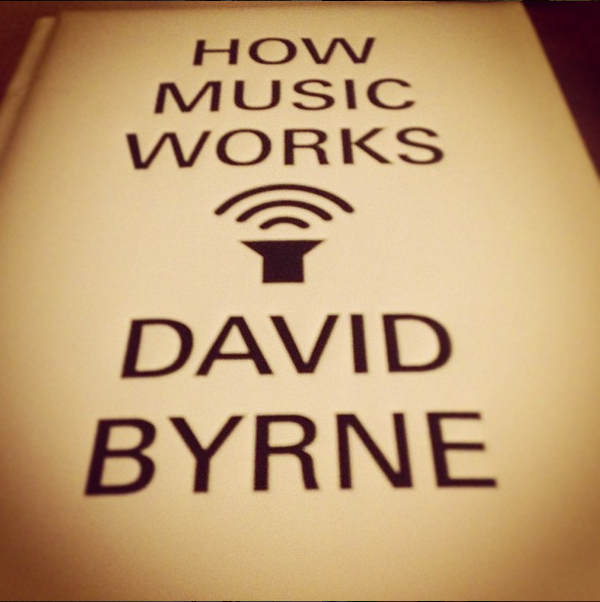
Dec
Reading in the Bathroom | How Music Works
[responsivevoice_button voice=”UK English Female” buttontext=”Listen to Post”]
Many know David Byrne from his work with Talking Heads, Brian Eno, and most recently, St. Vincent. But to me, Byrne will forever be associated with Jonathan Demme’s seminal rock film, Stop Making Sense.
Video: “Slippery People” from Stop Making Sense
At a very early age, my parents and I watched Stop Making Sense on repeat. My mom still has a story of the time I bumped my nose wanting to run around the dining room the way David ran around the stage.

Byrne isn’t simply a New Wave or World Music icon. With his lean frame, gentle spirit, and open-mindedness, it was easy for me at 7 years old to confuse him with a slightly more irreverent Mr. Rogers.
The book itself, with its puffy white cover, is disarming. It belies the clear vision inside. Because he opens with the line, “We’re All Africans.”
 Some say that the instruments being played in the photo (E) … were all derived from easily available local materials, and therefore it was convenience (with a sly implication of unsophistication) that determined the nature of the music. This assessment implies that these instruments and this music were the best this culture could do given the circumstances. But I would argue that these instruments were carefully fashioned, selected, tailored, and played to best suit the physical, acoustic, and social situation.
Some say that the instruments being played in the photo (E) … were all derived from easily available local materials, and therefore it was convenience (with a sly implication of unsophistication) that determined the nature of the music. This assessment implies that these instruments and this music were the best this culture could do given the circumstances. But I would argue that these instruments were carefully fashioned, selected, tailored, and played to best suit the physical, acoustic, and social situation.
Come thru, David Byrne! He consistently contextualizes our music experiences and finds similarities across genres, cultures, and time periods.
He’s also incredibly detailed. For example, in his staging of Stop Making Sense, Byrne was very detailed about every visual aspect of the stage. He insisted everyone wear grey tones (to be visible at both daytime and nighttime), and that all the metal hardware — down to the cymbal stands and keyboard racks — painted black.
As a graduate of the Rhode Island School of Design (RISD), it makes sense that he’s capable of forming these conclusions. Music, like design, serves a purpose and simply does not happen because of a desire for individual expression.
My only criticism is how Byrne blithely passes over how and why Talking Heads broke up (and to this day, estranged). Though, I wonder if his obsessive nature may have much to do with that.
The second half of the book is dedicated to the business of marketing and profiting from music. That section, while very informative, was of very little interest to me. I think, however, a young musician looking to understand their options would find this section extremely valuable.
What I like about Byrne is that he never wears nostalgia goggles. He always looks at the past with a very clear, complicated view. He is progressive in his choices. He is always interested in moving forward; the next thing. He is very comfortable experimenting even if things fail, such as his mid-90s mambo experiment (I never got it, but I appreciated it because he tried). Because he never forgets his very distant — yet very influential past — David Byrne is one of the last great griots of the late 20th century.
Reading in the Bathroom is a book review series by IDSL. Reading is obviously not done in the bathroom exclusively. Sometimes it’s at a park bench, outdoor cafe, or on the train. But the best reading is done in the bathroom.


